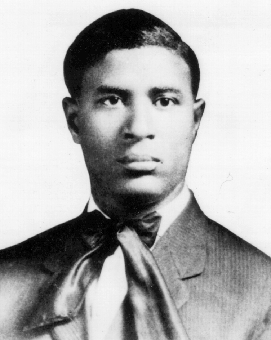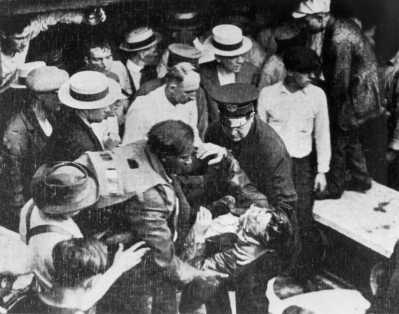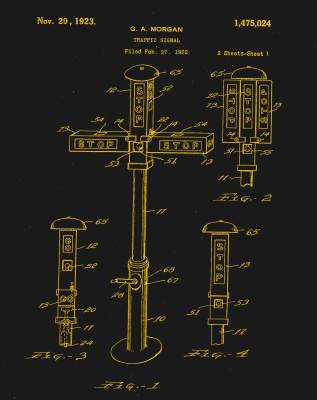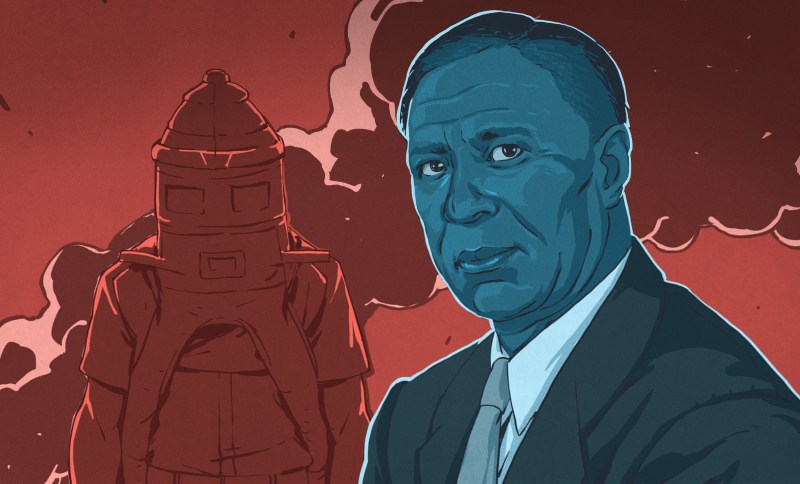Some people invent with the intent of seeking fame and prestige. Few inventors seem to truly care about other people the way that Garrett Augustus Morgan did. His inventions saved many lives, including those of a few people who were rescued by Garrett himself after an explosion tore through a tunnel beneath Lake Erie.
Though he had little formal education, Garrett’s curiosity took him into many fields from sewing machine repair to gas masks to transportation problems. He achieved great success and improved many lives along the way.
Of Seams and Straighteners

Garrett Augustus Morgan was born March 4th, 1877 in Claysville, Kentucky. He was the seventh of eleven children born to Sydney and Elizabeth Morgan, who had both been slaves. His mother was part Native American.
Armed with a sixth grade education and ten cents in his pocket, Garrett left home at fourteen look for work, which was common for kids his age at the time. He first landed in Cincinnati and spent a few years working as a handyman.
In 1895 he moved to Cleveland and started repairing sewing machines. This is where he developed his taste for the way things work. After a decade or so, he opened his own sewing machine shop. He had gotten married in the meantime, and a few years later, he and his wife Mary Anne, a seamstress, opened a discount ladies clothing store and hired thirty-two employees to make all the suits, coats, and dresses in-house.
One day Garrett was sewing a woolen fabric that kept getting scorched by the extremely high speed of the sewing machine needle. He experimented with a few chemicals to coat the needle and keep it cool. As the story goes, he wiped his hands off on a piece of cloth and went to lunch. When he came back, the wavy fibers in the fabric had been completely straightened by the chemical.
Curious, he tried the solution on his neighbor’s dog’s fur, and it straightened that, too. Then he worked up the nerve to try it on his own hair, and discovered the hair relaxer. He turned the solution into a cream and established the G.A. Morgan Hair Refining Company to sell his hair relaxer to African Americans. The company was terrifically successful and Garrett earned enough money from sales to keep inventing.

A Hero in Pajamas
In 1914, Garrett patented a safety hood that shielded the wearer from inhaling smoke and noxious gases. The hood worked on the principle that smoke rises, and featured long hoses that brought cool, clean air up from ground level. The hood also used a wet sponge to cool and filter the incoming air.
Garrett promoted the device to fire departments and often demonstrated its effectiveness himself. It won first prize at the Second International Exposition of Safety and Sanitation, and became the prototype for the gas masks used in World War I.
When it came to showing the hood to the public, Garrett distanced himself from the invention. He would hire a white actor to pose as the inventor while he himself portrayed a Native American man named Big Chief Mason. Garrett would demonstrate the hood’s effectiveness himself by building a chemical fire in a tent and then sit inside it for twenty minutes.

One early morning in 1916, Garrett’s breathing apparatus was spontaneously put to the test. City workers were drilling a fresh water supply tunnel beneath Lake Erie when they hit a pocket of natural gas. The resulting explosion trapped several workers underground, breathing mostly toxic fumes and dust.
Someone roused Garrett from bed, and he and his brother Frank rushed to the tunnel in their pajamas with Garrett’s ventilation hoods in tow. They managed to save two lives before the rescue operation was shut down.
Unfortunately, the publicity hurt sales because people found out that the inventor of the smoke hood was African American. Garrett and his brother weren’t recognized by the city for their heroic efforts at Lake Erie until much later. Although the mayor had been at the scene and called them heroes, the newspapers only mentioned them in passing.

A Better Traffic Signal
No matter how he was received, Garrett couldn’t stop his desire to invent things. He was an early adopter of the automobile and eventually developed a friction drive clutch. In 1923 he designed a new kind of motorized traffic signal after witnessing an accident at a notoriously bad intersection.
At the time, traffic signals were basically ‘stop’ and ‘go’ with no warning between the two. Garrett’s signal had a warning light that told drivers they would need to stop soon — the yellow light. It also had a ‘stop all directions’ setting that gave pedestrians time to cross the street. Although Garrett acquired patents for the traffic signal, he reportedly sold the rights to General Electric for $40,000.
Garrett began developing glaucoma in 1943 and lost most of his sight. He died in 1963, one month before the centennial celebration of the Emancipation Proclamation where he was recognized by the government for his achievements.
Garrett Augustus Morgan was a great inventor who wanted to make people’s lives better, and did so in the most varied ways. He deserves recognition for his heroic efforts at Lake Erie as much as his lifesaving inventions.
















Great read! Shame that the city of CLE does not have anything where his house used to be.Just an empty lot.
Thanks for these stories. It’s good to be reminded where some basic things came from, that we take for granted today.
I completely agree. I really enjoyed this article. Thanks Kristina!
Nice!
Total champ!
Amazing to realise how recent an invention breathing apparatus is. And great to see he demoed it himself.
One of my fave photos is an inventor of an early bullet proof shield demonstrating it by being shot himself.
Great men like that would not have launched a dummy in a car into space.
You can slam the achievements Of Elon Musk by knocking a bit of showmanship but at least he didn’t electrocute an elephant, as did Thomas Edison, to demonstrate the dangers of his rivals AC electric grid. Oh, and by the way, he almost single handedly launched the electric car revolution and commercial rocketry. Get over it!
For what it’s worth, it was traditional for armor makers to put on the armor and let the purchaser test it. A number of medieval and renaissance armors have small dents that have been worked into decorations, as the new owner chose to go ahead with the purchase and asked for decorations to hide the proof mark.
There’s a child’s suit of armor in one of the armor museums in Denmark that has a big hole in the front and a dent in the back, where a crossbow bolt went through it. The docent claimed it was made of metal that wasn’t thick enough because it was for a child and because the armorer was unable to wear it so didn’t bother making it strong enough. (although, if you’re going to get shot, any armor is better than none.)
I am doubtful about that last statement of your post.
In one scene in an episode of British TV parody series “Alo, alo”, the innkeeper Renne intends to use a metal plate as a shield beneath his clothes, preparing for pistols duel with the undertaker. Renne’s friend lt.Gruber, a German officer who is experienced duelist, says “no, the plate will only flatten the bullet, which will then make an even bigger hole”.
Well, I never expected Allo Allo to be cited for ballistics knowledge on Hackaday.
“good moaning”
Sort of right. Armours were proofed, but not as a common practice by having the maker wear it. It was generally done during the manufacture by the maker. As far as I am aware it was a practice that post dated the introduction of firearms, or at least it was far more common then. A child’s armour would never be proofed because there was never any intention for them to be used in combat, and a child can’t really take the weight of a bulletproof breastplate. They were primarily intended as toys or training aids.
Awesome! Great man focused on survival required implements maintenance and development… along with implementation.
Scary on some days how not only modern the history of intellectual thinking is; in general, more-so for others health and safety.
Another reminder that Electroboom so candidly noted in one of his episodes how the U.S. was the only country where marrying your first cousin… or even third… was outlawed… unlike his country.
And yet they are punchline in all the incest jokes…
No, there’s a bunch of countries where it’s illegal, and as far as I know there’s nowhere where marrying your third cousin is illegal, but what does that have to do with a pioneering inventor?
Ah, not sure what I was thinking in regards to third cousin. Guessing was hard laboring outside prior, so the mind was in body mode versus brain mode. For some reason I was recalling three degrees of separation genetically and wrote third cousin instead. Right, usually is only the first degree cousin that is unlawful and illegal.
In regards to the pioneering inventor not being so inbred, I was stressing the point of inbreeding causing an increase in mental health or neurological conditions that can impair logical thought processes like memory and memory associations.
Not that serendipity doesn’t happen; though many, like myself, try to learn as much as possible to increase the logical memories stored so the probability of making more complex memory associations that are novel or requiring more re-enforcement are affirmed.
Always wondered who came up with the yellow traffic light.
Very good read!
What an odd collection of inventions, though! A hair relaxer, as a side-product of a search for a fabric fire treatment. A proto-gas-mask. The yellow light.
Makes me wonder if we’re over-specializing these days, or if we’ll be looked at from some future society as having the freedom to pick multiple jobs over a lifetime…
He was a true problem-solver. Think of how scary he would have been with the same intellectual curiosity and entrepreneurial drive, but with high-school or college-level instruction in a few scientific areas. Or less racists.
I always have the sense that most (skilled) people, through-out time, are fairly specialized. There are notable exceptions; they’re odd, hence notable.
And when you look back you’re only seeing those notable exceptions making it look like the dawn of the 1900s was some sort of steampunk-esque freakshow of inventors :).
I’ll top that. Years ago now. WQXR-FM here in NYC, a classical music station, sadly the only one left, which ran broadcasts of the different music performance entities from Cleveland. They were sponsored by the local Standard Oil company there, and the announcer would mention trivia about the city, that came up twice. So I knew about this amazing inventor well before Hack A Day.
“OXYmoron”
I see what you did here ;)
An OXYmoron invented OXIclean
https://en.wikipedia.org/wiki/OxiClean